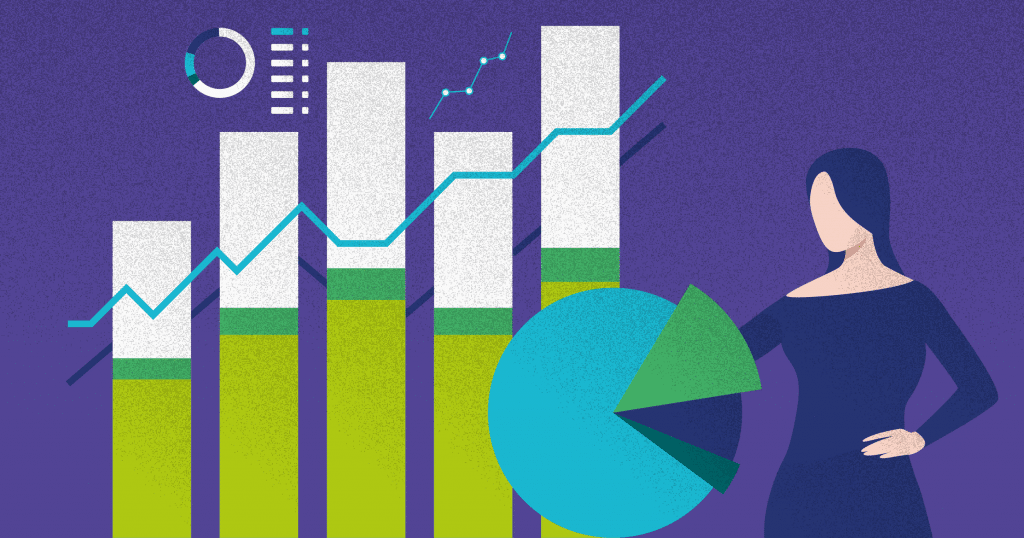Data visualization best practices: what are they?
Visualizations are great for getting a grasp of data sets, but sometimes the data is too big for a certain visualization technique.
Every type of visualization has limits on how much it can display while still being useful.
These limits are not due to the visualization alone. They also come from the capabilities of our brains to perceive and interpret what our eyes see. Different data visualization types rely on different skills of our visual system, so they each have distinct limits.
Let’s look at a few examples so we can understand how your company can best use data visualization to reach its goals. In this article, you will find the main types of graphs you can use and the data visualization best practices on how to use them.
Keep reading to find out more about:
- Pie charts
- Color schemes
- Bar and column charts
- Line charts
- Scatterplots
- Dual-axis charts
- Bullet graphs
- Bubble charts
Data visualization best practices for each type of chart or graph
Pie Charts
Pie charts are among the most popular visualizations for percentage data, but they aren’t appropriate for more than seven categories.
Because our brains are not particularly good at telling different angles apart, and even worse at telling how far apart distinct angles are from each other.
If you have a pie chart with more than seven categories, consider turning it into a bar chart. The part-to-whole relationship is no longer apparent, but typically it is more important to see the difference between distinct categories.
The data for the pie chart below was taken from an infographic submitted to Visual.ly.
It has far too many categories to be useful, although being sorted certainly helps it a lot. The bar chart shows the same data, but the part-to-whole relationship is not visible. In this case, that relationship is not critical, though.
What is more important is seeing not just which categories are ahead, but how much they are ahead (in this case, the only significant differences seem to be in the first two groups). Keeping the axis from 0-100% also shows the context of the values.

Color Schemes
You’ll notice in the charts above that the colors repeat. The same repetition was there in the original pie chart, only with different colors.
Colors are another limiting factor in many visualizations of categorical data. The maximum number of colors (with similar luminance values) that we can distinguish and remember easily is around 12.
The 12 colors below have been taken from Colorbrewer2.org, a great resource for categorical and continuous color scales.

Picking the right color for your graphs is very important. You should consider a palette that not only complements the data you’re portraying but also presents no issue with accessibility.
Colorblindness is a problem that can affect how your data is visualized, and at least 1 in 12 men face this challenge.
Because of that, you should always test your colors before settling on a color scheme.
There are a few easy ways to perform this type of testing. Tools like Colorblind Webpage Feature make it easy to test web pages and layouts for different types of colorblindness, such as:
- Pronatopia (red and green colorblindness, anomalous red cones)
- Deuteranopia (red and green colorblindness, anomalous green cones)
- Tritanopia (blue and yellow colorblindness)
- Achromatopsia (all forms of colorblindness).
Bar and Column Charts
Bar and column charts of categorical data also have an upper bound on the appropriate number of bars.
That number is limited by several things. Hypothetically, screen space is relevant.
After all, if you can’t see the whole chart at once, you rely on memory instead of visualization for the parts off the screen. Today, screens resolutions are typically high enough that pixel counts aren’t the limiting factor anymore.
So the limiting factors are slightly more complex and depend on several issues. First, what matters more in the data?
Is there an overall trend that is important, or is the difference between individual categories the focus?
If the overall trend is the most important factor, you might be able to get away with 50 bars or more. If individual differences are relevant, you probably want to keep the total number of bars under 12.
Every bar you add increases the number of comparison possibilities exponentially.
That is not to say that people make all of these comparisons when they look at a bar chart, they likely spot significant ones or big differences, and only make those.
The chart below illustrates how individual differences are hard to compare using too many bars, while overall trends are still visible.

Line Charts
Line charts are another visualization type with limits on the number of elements.
The number of points on the lines is only limited by screen space. However, the number of lines is limited by perceptual issues. Too many lines will cause people to have a hard time seeing and tracing each line, depending on line crossings.
The chart below was taken from a graphic submitted to Visual.ly. It only has seven lines, but the bottom ones cross a lot and at low angles to each other (try tracing the purple line).
That isn’t a deal-breaker for this particular chart because the red line with the huge spike is where the story is. However, not all data has the same story.

Line graphs can be a challenge when you’re building data visualizations for mobile-first websites. Depending on the device used by your readers, line charts can make comprehension difficult in smaller screens.
When designing data visualization for mobile, make an effort not to use the same data visualization tools you’re using on desktop.
Try different styles and schemes and always test with your users to find out if your solution works well.
Scatterplots
Scatterplots can easily show more elements than any other visualization for tabular data (the runner-up being parallel coordinates). There are several reasons for the high numbers.
The first reason is incredibly simple: dots don’t take up much space.
Second, since a scatterplot is good at showing a correlation between dimensions, the information really comes from the aggregate group, not from the individual.
For this reason, the space-consuming labeling necessary on other charts isn’t needed for many scatterplots.
In the example below, it is easy to see two groupings and some slight correlation within each group. With some color changes, axis labels, and explanatory text, this visual could take hundreds of elements and turn them into a small set of insights.

One critical thing to remember is that with almost all visualizations, the more elements there are, the longer people will need to spend examining the image before they can interpret the information.
For an infographic intended to make a point, quick and easy is probably the goal. Bottom line: if your data is too big, you may need more analysis to distill it down to the essential parts.
Moreover, some strategies, such as data storytelling, can be very useful in making the information more comprehensive.
Dual-Axis Charts
Dual-axis charts are a great visualization tool when you need to present two data sets with vastly different scales.
This type of graph makes sure all your information is presented on a single screen, which makes for better visualization as users do not have to flip between charts to compare the information displayed in both of them.
Dual-axis charts can use two types of visual representation in them to separate the information feature. It can, for example, present some of the data in a bar or column chart, and the rest of it a linear chart.
The main concern when creating this type of graph is not to overdo it. Because you can present more information, it’s easy to forget that there’s a limit to what we can absorb by looking at a chart.
The more data you insert in a dual-axis chart, the more complex it is to read, and the less effective it is with users.
Try not to overwhelm your design, with either color or data, and remember other charting best practices to make sure this visualization adds to your presentation.
Bullet Graphs
Bullet graphs are a great way to show performance data and impress your viewer.
This type of visualization is very similar to a bar chart. While both share the same format, bullet graphs are usually packed with a lot more content and context that makes them easier to read and understand.
The goal with a bullet graph is to contextualize your data using the length of the main bar, also known as Feature Measure.
That line is usually perpendicular to a Comparative Measure that is used to determine base values so the reader can understand if the data they’re looking into is better or worse than average.
Colors are very important in a bullet graph and they usually appear on a shading scale. Only by looking at them, the viewer should be able to understand if the performance shown is great, average, or overwhelming.
These are the types of information that are usually displayed in a bullet chart:
- Monthly or yearly revenue
- Number of sales
- Amount of expenses
- Amount of profit
- Personnel evaluation.
You can, however, use this type of chart with any KPI that is relevant for your business and has a qualitative base for comparison.
Bubble Charts
Bubble charts are a great way to present financial data.
Besides that, this is the type of chart you will most often see used to emphasize performance relating to revenue and profit.
This chart is very similar to a type of visualization we looked into in this article, the scatterplot. Both use a Cartesian coordinate system to decide where information should be located. So, X, Y, and the grid all bring meaning to each bubble shown.
Colors are often used in a bubble chart to compare and establish a relationship between each bubble. Moreover, variations such as time or any other data can be placed in the graphs axis for easy access.

One thing that is really important to remember when using this graph is that it works similarly to Proportion Area Charts, in which each of the circles’ sizes should be based on the area they occupy and not the radius or diameter of what is being measured.
Because of that, the size of the cycles does not change exponentially. This data visualization technique is important to remember; otherwise, your graph will lead to misinterpretations.
When figuring out the best way to present data, always remember the following tips. They will help you build a data visualization that is easy to understand, refer to, and makes for shareable content.
- Data visualization should always consider the needs of the audience. Think of who your graph or chart is designed for before picking out the best way to present information.
- Always establish what action you expect from the user after interacting with one of your graphs. This way, you can rely on KPIs to understand if you’ve reached your goal.
- Choose the visual based on the purpose and not on how it looks on your presentation.
- Do not forget to add as much context as possible to the data you present. This information will lead to more trust and make your content more easily digestible.
Understanding how those data visualization best practices work will help you build better graphs for your audience.
However, finding the right tool for data visualization is the one thing that will make it easier to maintain these tactics under perspective and apply them to every single one of your graphs.
Are you ready to start using these data visualization best practices to get ahead of the competition? Get a quote for design and video creation with Visual.ly!










